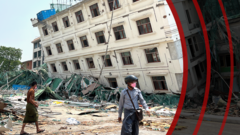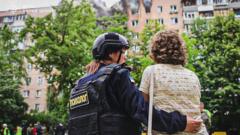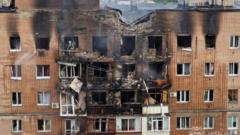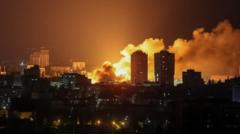A significant earthquake in Mandalay has left destruction in its wake, with many buildings collapsed and essential relief absent. Families are grappling with loss and uncertainty as local resources become strained amid ongoing political turmoil.
Devastation Unfolds in Mandalay: Struggling Earthquake Survivors Face Dire Circumstances

Devastation Unfolds in Mandalay: Struggling Earthquake Survivors Face Dire Circumstances
A BBC report highlights the catastrophic impacts of a recent earthquake in Mandalay, Myanmar, where few rescue efforts are underway, leaving survivors in despair.
Driving into Mandalay, the devastation from last Friday’s powerful earthquake was starkly visible, revealing a city in ruins. Numerous streets showcased collapsed structures, with nearly every building exhibiting signs of severe damage, creating an atmosphere of fear and uncertainty. The local hospital has resorted to treating patients outside due to infrastructural damage.
Myanmar's military regime has restricted foreign media access following the disaster, compelling some reporters to infiltrate quietly. Survivors lament the little assistance available. "I believe he's alive," said 41-year-old Nan Sin Hein, anxiously waiting for her son Sai Han Pha, a construction worker trapped under collapsed debris.
The earthquake, measured at a magnitude of 7.7, caused the bottom of several buildings to sink while the tops leaned dangerously, leaving Sai and four others trapped inside a converted hotel. While authorities called for international aid, the ongoing civil unrest and strained relations with foreign nations have complicated the assistance process, resulting in limited rescue efforts focused mainly on high-risk sites.
Neeraj Singh, leading a disaster response team, described a challenging collapse pattern likened to a "pancake," severely diminishing survival probabilities. As rescuers battle the sweltering heat, the sight of recovering bodies adds an emotional toll, resonating with grieving families anxiously awaiting news.
Many have converted parks and open spaces into temporary shelters while enduring aftershocks that feed their fears. "I lost everything. I’m now living under a tree," said 72-year-old Daw Khin Saw Myint, illustrating the dire living conditions faced by countless displaced people.
Reports indicate that nearly 2,886 have officially died, though this number may not reflect reality due to the ongoing search for victims trapped under rubble. Streets serve as makeshift camps as individuals seek basic necessities, often scrambling for limited supplies and food donations.
The local hospital struggles with a shortage of medical personnel, forcing families to assume caregiving roles. As hope dwindles for finding survivors, those impacted confront heartbreaking realities. "I want to see my son's face, even if he is dead," Nan expressed, encapsulating the heavy burden borne by the affected families in Mandalay.






















